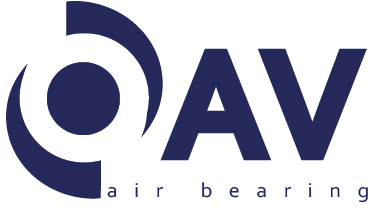

FAQ
What is OAV Air Bearing Material and Technology?
OAV Air Bearings brings aerospace technologies to air bearing systems. Crafted with aerospace quality aluminum and titanium that meets military specs along with a porous carbon material, OAV Air Bearings uses exotic aerospace material to push the limit of engineering for ultimate accuracy, speed, and performance.
Air bearings, also referred to as air cushions or air casters, operate by using pressurized gas (typically air) to create a frictionless bearing surface. This technology is widely utilized in industries such as manufacturing, transportation, and metrology, where precision and clean, frictionless movement are crucial.
Air bearings work by using pressurized gas, usually air, to create a thin film of gas between two surfaces. This thin film of gas acts as a lubricant, reducing the friction between the two surfaces and allowing them to move smoothly and easily against each other.
There are several types of air bearings, including journal bearings, linear bearings, thrust bearings, roller bearings, tapered bearings, and vacuum-preloaded bearings. Each type of air bearing operates on similar principles but is designed for a specific type of motion or load-bearing application. Contact the OAV Support team for your specific application.
The gas film acts as a lubricant, reducing the friction between the two surfaces and allowing them to move smoothly and easily against each other. This makes air bearings ideal for applications that require low friction, high accuracy, or clean operation.
Air bearings utilize pressurized gas (typically air) to create a thin film between two surfaces, resulting in low friction, high accuracy, and clean operation. These characteristics make them suitable for various applications. Compared to rolling element bearings and hydrostatic bearings, air bearings offer several advantages: - Low friction: The thin gas film minimizes friction, ideal for precise movement and low-friction operations. - High accuracy: Air bearings maintain precise positions and orientations over extended periods, perfect for applications requiring exact measurements or control. - Clean operation: They require no lubrication or maintenance, preventing contamination and operating effectively in diverse environments. - Long lifespan: With no wear and minimal maintenance, air bearings are cost-effective over time.
The accuracy of air bearings is almost entirely determined by the accuracy of the guide. To improve the accuracy, the guide will need to have high stiffness, excellent flatness, and the right surface roughness.
For best results, use the following tolerances:
Surface Roughness 16 micro-inch (0.4 micron) RMS or better
Grade A for high precision
Grade AA for ultra precision
OAV manufactures guide surfaces with state of the art measuring and testing equipment. OAV guarantees that tolerances are met and that the air bearings achieve the desired performance on the guide.
OAV Air bearings are made from Aircraft Quality Aluminum and Graphite. Graphite is a carbon that forms only two bonds with other carbon atoms. This means that it has free electrons and the graphite material exists in layers. This enables one layer to slip over another layer, making graphite an excellent lubricant. If the air supply shuts off, OAV Air bearings act as low friction bushings and it won't damage the platform or the bearing.
Porous media air bearings distribute air more evenly. Because of this, they offer the benefit of more load capacity, higher stiffness, better gap stability, and more. Additionally, the porous material (graphite) has a natural lubricity. Therefore, your assembly will still work even if the bearing briefly makes contact with the guide. An orifice air bearing however, will have metal-on-metal contact which could damage both the bearing and the guide. The porous media air bearings won't get damaged from contact.
Choosing the right size air bearing for your application is important to ensure that it performs appropriately and meets the requirements of your application. Here are a few factors to consider when selecting the size of an air bearing:
Load-bearing capacity: The load-bearing capacity of an air bearing is determined by the pressure of the gas film and the size of the bearing surfaces. It is important to ensure that the air bearing is capable of supporting the required load without failing or deforming.
Envelope Size
Accuracy
Operating conditions: The operating conditions of the air bearing, such as temperature, humidity, and contamination, can also affect its performance. It is important to consider these factors and choose a size that is appropriate for the operating environment.
Air bearings are used in high-precision applications such as semiconductor manufacturing, medical imaging devices, and aerospace testing, CMM, friction lion motion and automation systems . Their ability to operate without friction enhances accuracy, reduces maintenance costs, and increases efficiency.